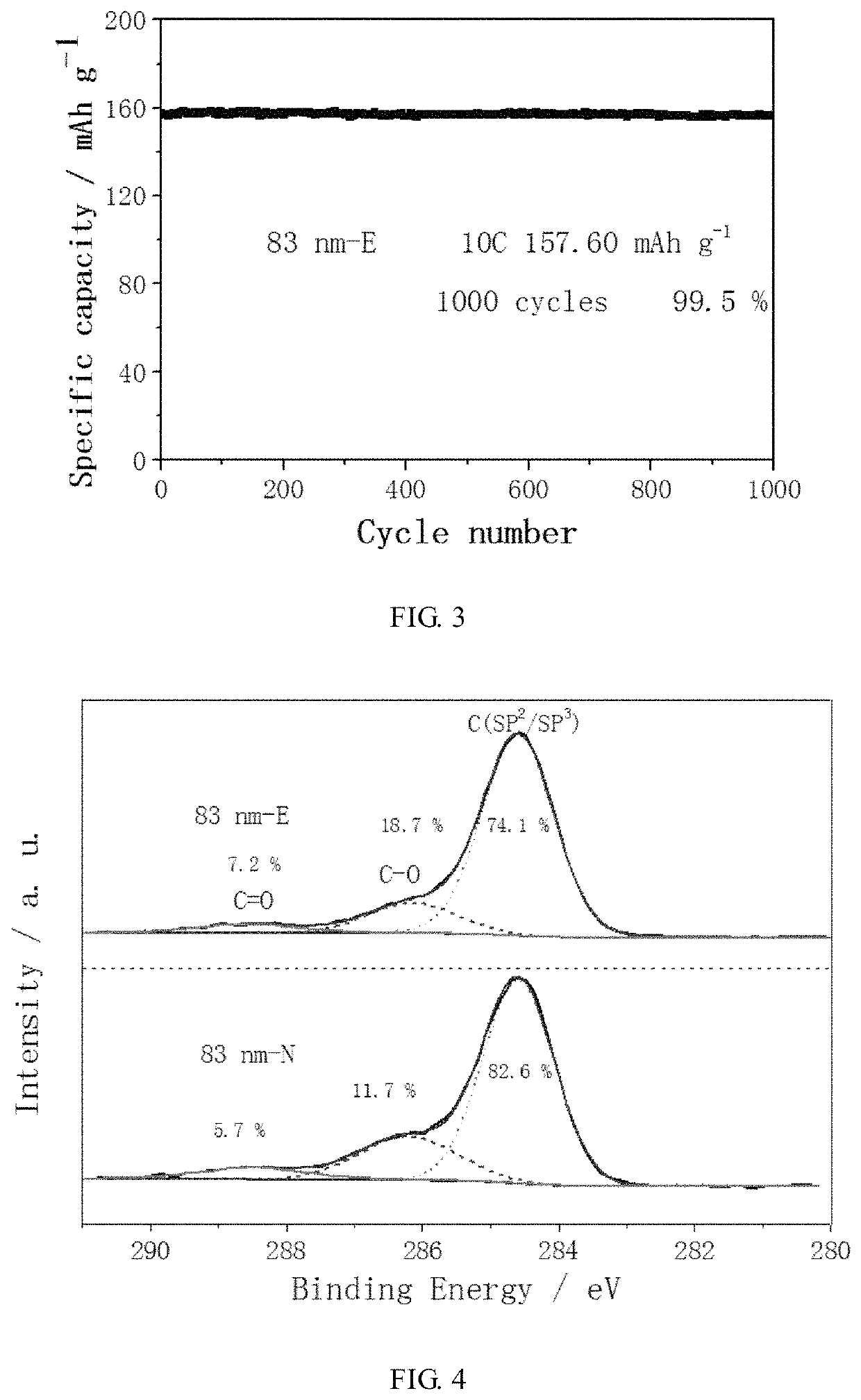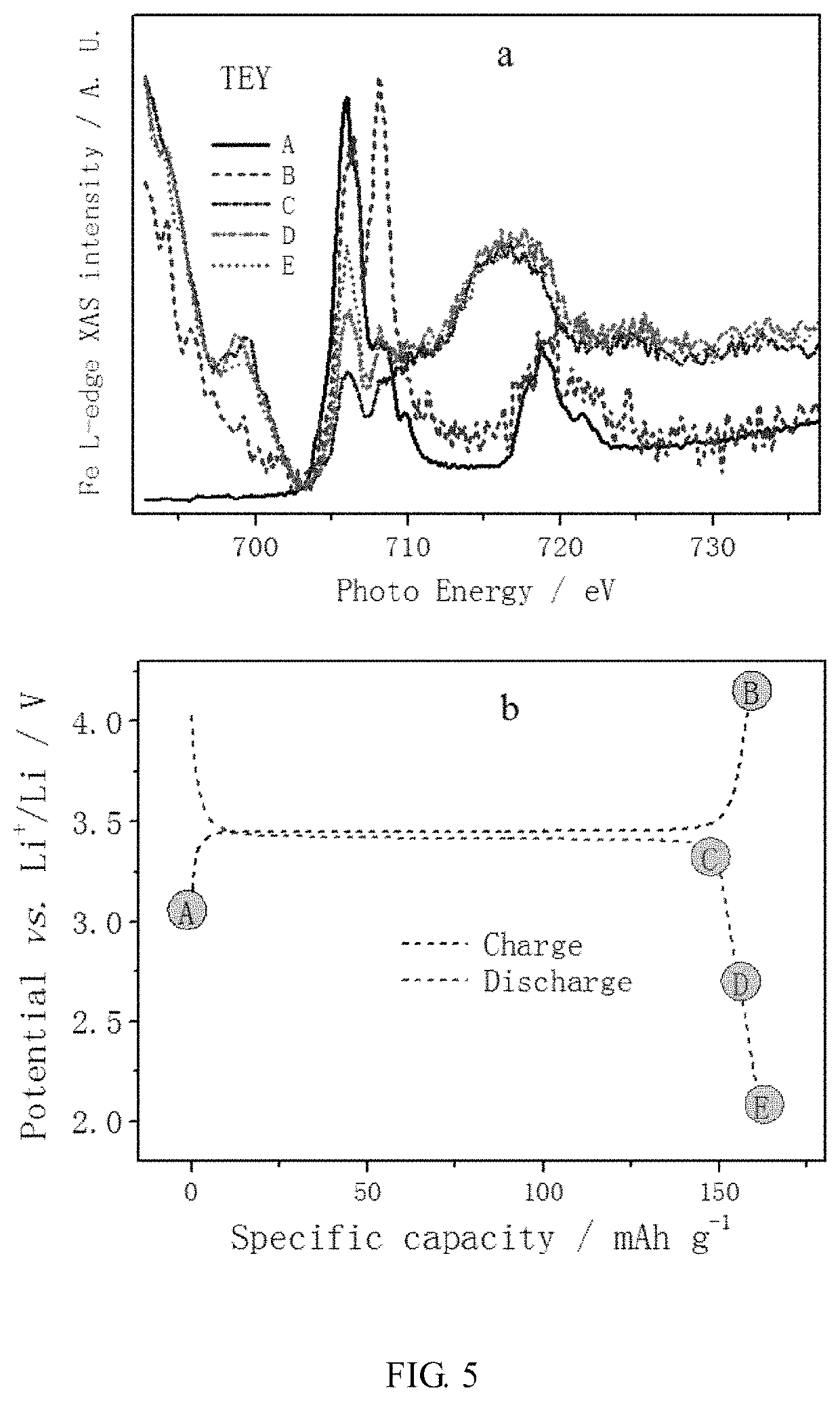Supercapacity lithium ion battery cathode material, preparation method therefor and application thereof
a lithium ion battery, supercapacity technology, applied in the direction of positive electrodes, active material electrodes, cell components, etc., can solve the problems of increasing the surface impedance of materials, nano-sized cathode materials have the disadvantage of low tap density, and nano-sized cathode materials have the disadvantage of low cathode capacity, so as to increase the gram capacity of cathode materials
- Summary
- Abstract
- Description
- Claims
- Application Information
AI Technical Summary
Benefits of technology
Problems solved by technology
Method used
Image
Examples
example 1
[0055]In this example, a conventional carbon-coated cathode material, and a carbon-coated super-capacity lithium-ion battery cathode material with transition metal-O—C chemical bonds to repair lattice interface, were respectively prepared.
[0056]Conventional carbon-coated cathode material: 1 g of lithium iron phosphate having an average particle diameter of 83 nm, 0.2 g of glucose, and 5 ml, of ethanol as dispersant were mixed, and the mixture was conventionally heated and dried. The resulting product was heated to 650° C. and kept at the constant temperature for 4 hours under an argon atmosphere, followed by natural cooling to obtain the LiFePO4 / C composite material.
[0057]Super-capacity lithium-ion battery cathode material: 1 g of lithium iron phosphate having an average particle diameter of 83 nm, 0.2 g of glucose and 10 mL of ethanol as dispersant were mixed, and the mixture was placed in a ball mill, and ball-milled into a nano-sized slurry at a rotation speed of the ball mill of...
example 2
[0064]To prepare the super-capacity lithium-ion battery cathode material in this example, 1 g of LiFePO4 having an average particle diameter of 42 nm and 0.3 g of melamine as a nitrogen-containing carbon source were dispersed in 10 mL of ethanol. The resulting mixture was ball-milled to dryness under nitrogen, and then heated to 750° C. and kept at the constant temperature for 6 hours under an inert atmosphere to obtain the super-capacity lithium-ion battery cathode material in this example.
[0065]The interface between LiFePO4 and the carbon layer was tested by X-ray photoelectron spectroscopy. The test results are shown in FIG. 8. The X-ray photoelectron spectroscopy indicated the formation of C—N bonds, confirming that a new interface, that is, a repaired lattice interface, was formed between LiFePO4 and the carbon layer in this example.
[0066]Likewise, the ultra-capacity lithium-ion battery cathode material in this example was assembled into a battery, and the battery was tested by...
example 3
[0067]To prepare the super-capacity lithium-ion battery cathode material in this example, 1 g of LiFePO4 having an average particle diameter of 42 nm and 0.2 g of thiophene as a sulfur-containing carbon source were dispersed in 8 mL of ethanol. The resulting mixture was ball-milled to dryness under nitrogen, and then heated to 850° C. and kept at the constant temperature for 12 hours under an inert atmosphere to obtain the super-capacity lithium-ion battery cathode material in this example.
[0068]The interface between LiFePO4 and the carbon layer was tested by X-ray photoelectron spectroscopy. The test results are shown in FIG. 10. The X-ray photoelectron spectroscopy indicated the formation of C—S bonds, confirming that a new interface, that is, a repaired lattice interface, was formed between LiFePO4 and the carbon layer in this example.
[0069]Likewise, the ultra-capacity lithium-ion battery cathode material in this example was assembled into a battery, and the battery was tested by...
PUM
| Property | Measurement | Unit |
|---|---|---|
| thickness | aaaaa | aaaaa |
| temperature | aaaaa | aaaaa |
| temperature | aaaaa | aaaaa |
Abstract
Description
Claims
Application Information
 Login to View More
Login to View More - R&D Engineer
- R&D Manager
- IP Professional
- Industry Leading Data Capabilities
- Powerful AI technology
- Patent DNA Extraction
Browse by: Latest US Patents, China's latest patents, Technical Efficacy Thesaurus, Application Domain, Technology Topic, Popular Technical Reports.
© 2024 PatSnap. All rights reserved.Legal|Privacy policy|Modern Slavery Act Transparency Statement|Sitemap|About US| Contact US: help@patsnap.com










